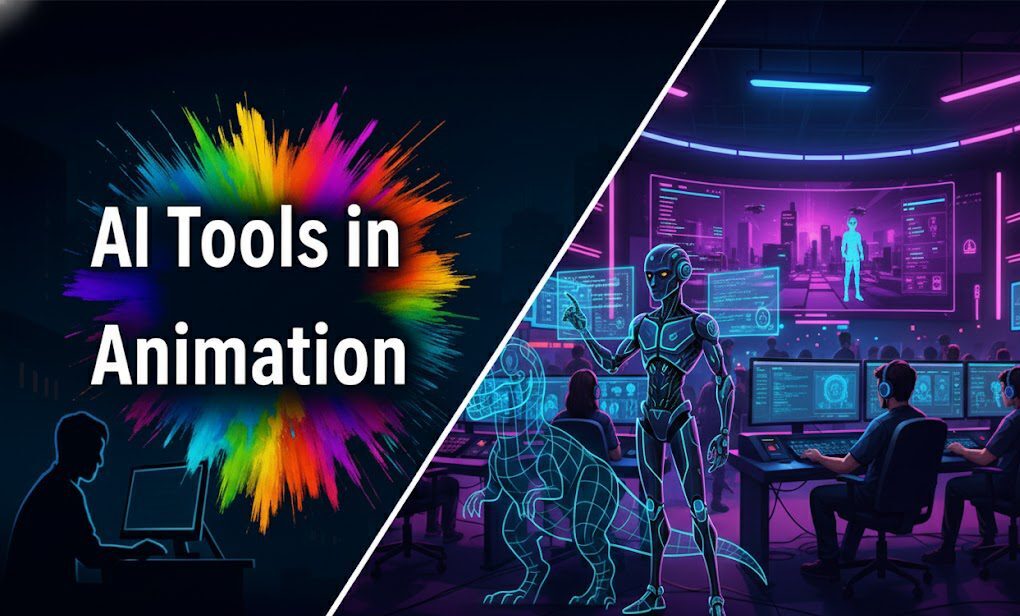The Strategic Impact of AI Tools in Animation

Introduction
For M&E studio executives tasked with navigating an evolving content landscape, the integration of Artificial Intelligence (AI) is no longer an abstract future trend—it is a critical, present-day mandate.
The content consumption environment, driven by global streaming demand and the constant pressure to reduce Time-To-Market (TTM), requires production methods that are radically more efficient and scalable.
This is particularly acute within the animation sector, an industry historically burdened by complex, time-intensive, and highly manual processes.
AI tools in animation represent the most significant operational disruption since the transition from cel animation to Computer-Generated Imagery (CGI).
This analysis is not focused on the creative debate, but rather on the strategic implications for the balance sheet and the supply chain.
I will break down how generative AI is automating the core animation pipeline, analyze the quantifiable Return on Investment (ROI) for studio operations, and explain how a comprehensive market intelligence platform is essential for vetting the right technology partners.
Table of content
- The Strategic Shift: Why AI Tools in Animation Demand Executive Attention
- Deconstructing the Generative AI in Animation Pipeline
- Measuring the Strategic ROI of AI Tools in Animation
- The Critical Role of Market Intelligence: How Vitrina Mitigates AI Risk
- Conclusion: The Future Animation Supply Chain is AI-Enabled
- Frequently Asked Questions
Key Takeaways
| Core Challenge | The animation supply chain suffers from high costs and slow turnaround times due to manual, repetitive tasks like rigging, in-betweening, and environment generation. |
| Strategic Solution | Implementing AI tools to automate 70% of manual production tasks, dramatically improving efficiency and shortening the production cycle from months to weeks. |
| Vitrina’s Role | Vitrina provides the verified intelligence to discover, vet, and track the global AI technology vendors and service providers that are transforming the animation production value chain. |
The Strategic Shift: Why AI Tools in Animation Demand Executive Attention
The animation industry is currently undergoing a period of exponential technological growth, moving from incremental software updates to wholesale process re-engineering via Artificial Intelligence. For any executive, understanding this shift means grasping two core drivers: escalating demand and critical efficiency gains.
Global demand for animated content, fueled by the proliferation of streaming platforms, requires studios to achieve unprecedented levels of scalability.
Traditional animation processes—where weeks or months are spent on repetitive tasks—cannot meet this volume mandate without ballooning budgets. AI tools in animation directly address this bottleneck by introducing automation to the animation production pipeline.
The market momentum behind this transformation is unambiguous. The global market size for AI tools specifically designed for animation is poised for significant expansion.
One projection indicates the market is expected to grow from $2.99 billion in 2024 to $37.80 billion by 2035, representing a Compound Annual Growth Rate (CAGR) of 26.01%. Another report projects the market to reach $7.45 billion by 2029 with a CAGR of 33.1%.
This magnitude of growth signifies a fundamental shift in capital investment, with the Media and Entertainment segment, alongside the rapidly growing gaming segment, serving as the largest revenue drivers.
The strategic mandate is clear: the most efficient and scalable content producer will be the one that can effectively integrate these tools.
Deconstructing the Generative AI in Animation Pipeline
Generative AI (GenAI) is transforming the animation workflow by automating or assisting in tasks across the entire production cycle.
For studio leadership, the value of GenAI is less about novelty and more about reducing the 70% of manual effort that historically characterizes animation production.
These AI tools in animation are not replacements for human creativity; they are accelerators for the M&E supply chain, allowing artists to focus on high-value creative decisions.
Measuring the Strategic ROI of AI Tools in Animation
The investment in AI animation tools must be justified by clear, quantifiable strategic benefits that resonate with the executive agenda: cost control, speed, and scalability.
The strategic benefits of AI in animation extend beyond simple task automation to encompass true production agility.
- Reduced Production Time: The most tangible benefit is time compression. Tasks that traditionally took days for an animator can be completed in hours or minutes using AI tools. The automation of keyframe animation and inverse kinematics alone offers up to 30% faster workflow optimization. This speed is paramount for keeping pace with the perpetual content needs of global streamers.
- Cost Efficiency and Scalability: By reducing the manual labor required for repetitive tasks, studios can allocate highly skilled human capital to higher-value creative work—the areas that require emotional intelligence and narrative instinct. AI’s ability to quickly generate background assets and character variations at a fraction of the traditional cost allows studios to produce more content with fewer resources, significantly enhancing scalability and return on investment.
- Creative Consistency and Quality: AI enhances realism by analyzing real-world physics and motion data, ensuring that elements like cloth movement, natural phenomena, and crowd simulations are highly believable. Crucially, AI-driven solutions help maintain character consistency across vast animation sequences—a factor that often compromises quality under tight deadlines.
To capture this ROI, studio executives must move beyond simple procurement and adopt a market intelligence approach. Vetting AI vendors requires deep data on their track record, their IP training data, and their specific expertise across the fragmented M&E supply chain efficiency.
The Critical Role of Market Intelligence: How Vitrina Mitigates AI Risk
The rapid emergence of AI tools in animation presents significant operational risk alongside its benefits. Concerns around Intellectual Property (IP), the sourcing of training data, and the long-term viability of small, specialized vendors are pervasive. For a strategy executive, the challenge is separating market hype from proven performance.
Vitrina is the essential tool for mitigating this risk. As the global leader in tracking the entertainment supply chain, Vitrina enables executives to move from fragmented vendor lists to data-driven strategic partnerships. It is an end-to-end market intelligence platform for the M&E industry.
Vitrina’s Core Capabilities in the AI Context:
- Vendor Vetting and Discovery: Vitrina offers comprehensive company profiling, tracking studios, streamers, and, critically, technology vendors globally. It allows users to source pre-vetted AI vendors or studios in specific markets, eliminating the high resource cost of building business pipelines manually.
- Project Tracking and Deal Mapping: The platform tracks Film & TV projects through development, production, and post-production stages. By correlating a vendor’s AI tools with their verified track record on current and upcoming projects, a studio can assess the vendor’s real-world impact and reliability. Executives gain early warning on upcoming projects in development/production for financing or pre-buy, a core capability of the Project Tracker.
- Verified Contacts: Vitrina houses a database of over 3 million CXOs and crew-heads tagged by department and specialization, providing the verified contact details necessary for immediate, high-level outreach, addressing the pain point of finding verified contacts for outreach.
In a market where the AI vendor landscape is fragmented and unproven, Vitrina provides the single source of truth for making confident, data-driven decisions about the future of your animation supply chain, addressing the common pain points in entertainment supply chain.
Conclusion: The Future Animation Supply Chain is AI-Enabled
The strategic narrative for AI tools in animation is fundamentally about content velocity and margin preservation. As the industry faces a perfect storm of accelerating demand and budgetary constraints, the adoption of generative AI is moving from a competitive advantage to a necessary condition for operating at scale.
The automation of the animation production pipeline, particularly in tedious tasks like rigging and in-betweening, promises significant ROI through faster production cycles and better resource allocation.
For M&E executives, the immediate task is not just to invest in AI, but to apply strategic intelligence to that investment.
A platform like Vitrina provides the verified, contextual data needed to vet partners, assess their track record, and integrate these advanced tools confidently into the complex, global entertainment supply chain.
The future of animation is being written now, and its core feature is the successful, intelligent deployment of AI.
Frequently Asked Questions
The global market for AI animation tools is forecast to grow significantly, with projections ranging up to a Compound Annual Growth Rate (CAGR) of 33.1% through 2029. This growth is driven by the media and entertainment sector, reflecting capital investment into production efficiency and scalability.
Generative AI automates labor-intensive tasks by creating content autonomously. In rigging, it analyzes 3D models to automatically generate the digital skeleton, and in in-betweening, it creates the necessary transitional frames between keyframes, maintaining fluid motion without manual drawing.
The primary ROI is realized through production time compression and cost reduction. AI-driven automation can reduce production time for key tasks by up to 30%, shorten rendering times by 50%, and allow creative staff to focus on high-value storytelling instead of repetitive manual labor, thereby increasing content velocity.
The main challenges revolve around ethical and legal uncertainties, particularly concerning copyright infringement and the sourcing of training data. High-profile litigation regarding the use of public internet data for training AI models poses a risk to the legal foundation of commercially used AI tools.

























